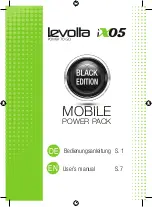
-6-
a.
GFCI and personal protection devices
like electrician’s rubber gloves and
f o o t w e a r w i l l f u r t h e r e n h a n c e y o u r
personal safety.
b.
Keep handles dry, clean and free from
oil and grease.
Slippery hands cannot
safely control the power tool.
c.
Use clamps or another practical way to
secure and support the workpiece to a
stable platform.
Holding the work by
hand or against your body leaves it
unstable and may lead to loss of control.
d.
D e v e l o p a p e r i o d i c m a i n t e n a n c e
schedule for your tool. When cleaning
a tool be careful not to disassemble
any portion of the tool since internal
wires may be misplaced or pinched or
safety guard return springs may be
improperly mounted.
Certain cleaning
a g e n t s s u c h a s g a s o l i n e , c a r b o n
t e t r a c h l o r i d e , a m m o n i a , e t c . m a y
damage plastic parts.
e.
Ensure the switch is in the off position
before inserting battery pack.
Inserting
the battery pack into power tools that
have the switch on invites accidents.
f.
U s e o n l y D r e m e l r e c o m m e n d e d
accessories.
Other accessories may not
fit properly and lead to injury.
g.
Do not use standard flat wheels for
face grinding.
Side forces applied to
these wheels may cause them to shatter
or burst.
h.
Do not attempt to cut large stock or
sheets of metal as this machine is not
designed to be a dedicated cut-off
machine.
i.
Do not collect dust (wood or metal) in
ordinary household vacuum cleaner.
L i n t a n d o t h e r f i b e r s i n h o u s e h o l d
vacuums are easily combustible and may
start a fire.
j.
D o n o t v a c u u m a n d c o l l e c t m e t a l
s h a v i n g s / d u s t w i t h w o o d s a w d u s t .
Metal shavings/dust becomes very hot
during abrasive cutting and will ignite
wood dust.
k.
When connecting tool to dust collection
and extraction systems, be sure these
are connected and used according to
tool and vacuum instructions.
Proper
use of dust collection can reduce dust
related hazards.
l.
When using tool with dust collection and
extraction systems, empty the dust
container before beginning work,
frequently during work, after completion
of work, and before storing the tool.
be
extremely careful of dust disposal,
materials in fine particle form may be
explosive.
m. Do not throw dust on an open fire.
Fine
dust particles may burn explosively.
n.
When performing sanding and surface
preparation operations with tool
connected to a dust collection and
extraction system be aware of the
materials creating the dust.
Combustion
from mixture of varnishes, lacquers,
polyurethane, oil or water with dust
particles can occur if there is a static
discharge, electric spark, or excessive
heat causing a fire in the dust collection
and extraction system.
o.
Do not use dust extraction for
operations that include burning,
smoking or smoldering items like hot
ashes or sparks.
Fire inside the vacuum
tank or bag may occur. Dust may smolder
and set vacuum on fire long after work is
completed.
p.
Do not use dust extraction with
explosive dusts, varnish, polyurethane
coatings, cleaners, or oil-based paints.
Electric motors create sparks which may
ignite the dust or fumes.
q.
Do not use dust extraction when
working on metal.
Swarf from sanding,
grinding or cutting metal may be hot and
may spark which may melt plastic
adaptors, vacuum hoses, and may cause a
fire inside the vacuum tank or bag.
Some dust created by
power sanding, sawing,
grinding, drilling, and other construction
activities contains chemicals known to
c a u s e c a n c e r , b i r t h d e f e c t s o r o t h e r
reproductive harm. Some examples of
these chemicals are:
•
Lead from lead-based paints,
•
Crystalline silica from bricks and cement
and other masonry products, and
•
Arsenic and chromium from chemically-
treated lumber.
Your risk from these exposures varies,
depending on how often you do this type of
work. To reduce your exposure to these
chemicals: work in a well ventilated area,
and work with approved safety equipment,
such as those dust masks that are specially
designed to filter out microscopic particles.
Additional Safety Warnings







































